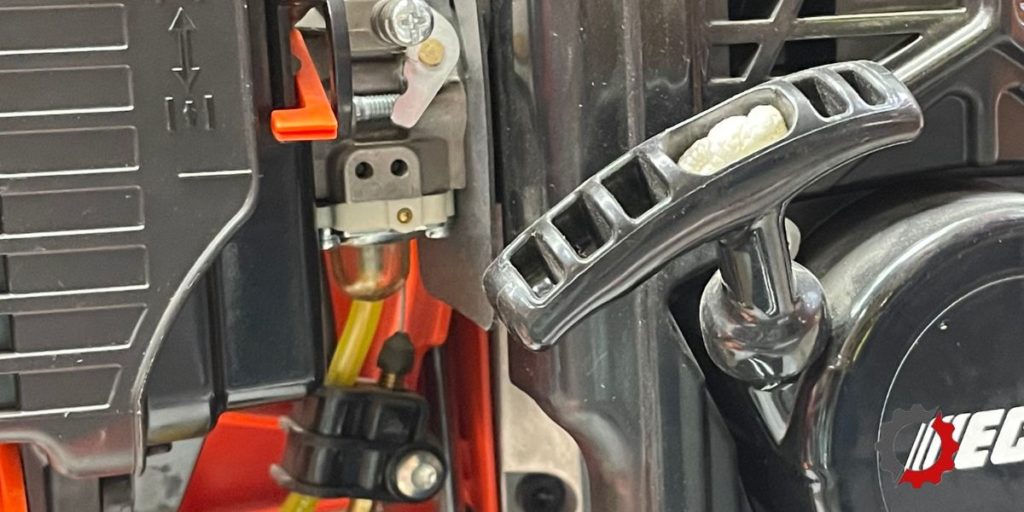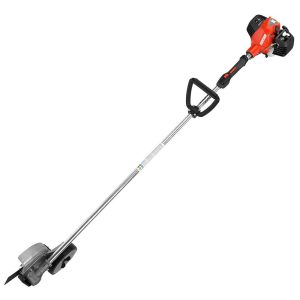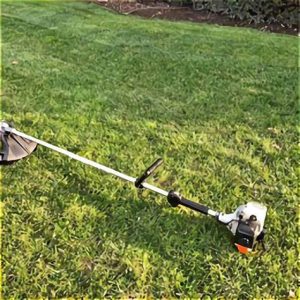Your ECHO Leaf Blower Starts, Stalls and Dies
You have a big leaf removal project ahead of you so you turn to your ECHO leaf blower to get the job done. You use it for a little while and it just quits on you. Without your leaf blower, you’ll have to resort to using the time-consuming labor-intensive leaf rake.
An ECHO leaf blower will start and die when it isn’t getting air, fuel, or spark due to a plugged air filter, incorrect choke setting, bad fuel, plugged fuel filter, clogged fuel line, plugged fuel tank vent, dirty carburetor or bad spark plug. It may also die when the spark arrestor has a buildup of carbon.
Always remove the spark plug wire to prevent the blower from starting. Wait for all moving parts to stop and for the engine to cool down before performing any repairs.

This post may include affiliate links. Purchases made through these links may provide a commission for us, at no extra cost to you. As an Amazon Associate, we earn from qualifying purchases.
Follow all safety instructions provided in your equipment operator’s manual prior to diagnosing, repairing, or operating.Consult a professional if you don’t have the skills, or knowledge or are not in the condition to perform the repair safely.
Table of Contents
8 Reasons Your ECHO Leaf Blower Starts Then Dies
Incorrect Choke Setting Causes an ECHO Blower to Start Then Die
You will find a choke lever on your ECHO blower that is used to start a cold engine. A cold engine requires more fuel than a warm engine to start.
To start a cold engine, place the choke lever in the on position to restrict airflow. After the engine starts and warms up, you must adjust the choke lever to the off position or your ECHO will die because it isn’t getting enough air to keep running.
Plugged Air Filter Causes an ECHO Blower to Start Then Die
One of the first things to check on your ECHO blower if it shuts down or loses power is the air filter. The air filter protects the engine by preventing dirt and debris from passing through the filter and wearing on the engine.
Because you are working in very dusty conditions, the air filter is prone to get dirty and must be cleaned or replaced regularly. If it becomes so dirty that sufficient airflow isn’t able to pass through the filter, your ECHO blower will sputter and die.
When you find your air filter is not in good condition because it is damaged, wet, very dirty or doesn’t seal properly, replace the filter.
Never run your blower without a filter even if it’s just so you can get your job finished. Doing so may allow dirt into the engine that will wear on the engine causing damage.
For the average homeowner, I recommend replacing the air filter once a year and more often if you notice it is in poor condition when you check it several times throughout the year.
If you’re using your ECHO leaf blower more than the average homeowner or in extremely dirty conditions, you will need to check it more frequently.
Clean an ECHO leaf blower FELT or PAPER air filter:
- Place the choke in the closed position to keep dirt from falling into the carburetor throat.
- Remove the air filter cover and remove the air filter.
- Wipe any dirt or debris remaining in the air filter cover or housing.
- Brush the dirt off the air filter. Replace it if it is very dirty.
- Install the clean filter.
- Reattach the air filter cover.
Clean an ECHO foam pre-cleaner filter (if your model uses one):
The pre-cleaner can be cleaned with water and a mild dish detergent solution. Rinse until the water runs clear and squeeze to remove all water. Allow it to dry before installing. DO NOT ADD OIL to a pre-filter.
Because there are so many different types of filters used which varies from model to model, refer to your operator’s manual for steps to clean different types of filters used in your ECHO leaf blower.
Old or Bad Fuel Causes an ECHO Blower to Start Then Die
It does matter what type of gas you use in your ECHO leaf blower and how fresh it is. Old gas and gas with high levels of ethanol will increase the problems that develop in your fuel system and how your blower runs.
Most types of gasoline contain ethanol, a product added to make it more environmentally friendly. This alternative fuel is often made of corn, but can also be made from other high-starch content plants.
Ethanol attracts moisture to the fuel system. The ethanol and water mixture leaves behind varnish and gums the fuel system that can damage the fuel components and restrict fuel flow.
High levels of ethanol are not good for the small engine on your blower. You need to make sure you are using unleaded gasoline with a maximum ethanol content of 10% and an octane rating of 89 or higher.
ECHO 2-cycle leaf blowers require a gasoline and oil mixture. Gasoline must be mixed with premium 2-cycle engine oil that is ISO-L-EGD and JASO M345 FD certified. This oil is different than your standard engine oil.
Using the wrong type of oil or the wrong amount of oil can result in engine damage. Never run straight gas through your ECHO blower. Gas runs very dry and the engine will seize without the added lubrication of 2-cycle oil.
Use a fuel stabilizer in your ECHO blower
Gas can begin breaking down as soon as 30 days after purchase. Add a fuel stabilizer like Sea Foam Motor Treatment to fresh fuel to make it last a little longer without breaking down. A fuel stabilizer can help minimize fuel issues from running old gas.
Keep in mind some 2-cycle oils include a fuel stabilizer. Even though the bottle of oil states it includes a stabilizer, read the fine print to see how long the additive will keep the fuel stable.
If it doesn’t state a timeframe, don’t assume it will work longer than 30 days. Read more about choosing the right gas and how to care for it in “This is the Type of Gas ECHO Leaf Blowers Use“.
Plugged Fuel Filter Causes an ECHO Blower to Start Then Die
Just like the air filter is used so your blower gets clean air free of dirt and debris, a fuel filter is used to keep dirt and debris out of the fuel system.
You will find the fuel filter located inside the fuel tank. It is attached to the end of the fuel line. The filter can become plugged with dirt causing your ECHO blower to die.
It must be regularly replaced to avoid this. I recommended changing the filter out at least once a year. When using your blower for commercial purposes, you should change it once every 3 months.
Replace an ECHO fuel filter:
- Wipe around the fuel cap to remove dirt and debris so they don’t fall into the tank.
- Remove the cap.
- Pull the fuel filter out of the fuel tank. A clean bent wire works well to retrieve the filter.
- Once the filter is out of the tank, remove it from the fuel line. Be careful not to lose the retaining ring. Keep the ring on the fuel line.
- Attach the new fuel filter by inserting the male end into the fuel line and securing the line to the filter using the retaining ring.
- Place the fuel filter back inside the fuel tank.
- Install the fuel cap.
Clogged Fuel Lines Cause an ECHO Blower to Start Then Die
Old fuel can leave behind gummy deposits that can restrict fuel flow through the fuel lines. When this happens, remove the fuel line and install a new fuel line of the same diameter and width.
You will need to replace the fuel line if you find it is dry, cracked, or kinked.
Plugged Fuel Tank Vent Causes an ECHO Blower to Start Then Die
The ECHO fuel tank requires a vent to allow air to pass through it. When this vent gets plugged, the fuel tank forms a vacuum. The vacuum prevents fuel from flowing out of the tank which causes the leaf blower to stall and die.
If you are not getting fuel to the carburetor, and have verified you are running a good filter and you don’t have any clogs in the fuel lines, you may have a clogged fuel vent. You can test this by placing your ECHO leaf blower on a level surface.
Loosen the fuel cap to allow air into the tank and start the blower. Don’t allow gas to spill out of the fuel tank. When the blower starts and runs, replace the fuel cap with the blower still running.
Continue to let it run for a while. If it sputters and dies with the cap on and then starts and runs once the cap is removed, you most likely have a problem with the fuel tank vent.
Replace the vent with a new fuel tank vent. This is a small part that is found coming off a line out of the fuel tank.
Dirty Carburetor Causes an ECHO Blower to Start Then Die
The carburetor mixes the correct proportion of air and fuel required for your ECHO leaf blower to start and continue to run. The passageways can become clogged and the small components can fail to function correctly which can be the reason the blower stops running.
Old fuel is a big reason why an ECHO carburetor will stop working. You may be able to clean or rebuild your carburetor to get it working again. You will have to replace the carburetor if this doesn’t work.
Plugged Spark Arrestor Causes an ECHO Blower to Start Then Die
There is a small metal screen that keeps hot exhaust material from shooting out of the leaf blower and causing injury or starting a fire. This small screen will become plugged with a buildup of carbon that will affect how the engine runs.
Disconnect the spark plug wire. On most ECHO blower models, you will remove the engine cover and the engine exhaust cover to access the spark arrestor screen. Carefully remove the spark arrestor screen. Clean the screen with a metal brush.
If the screen isn’t able to be sufficiently cleaned or you find it is damaged or has a hole in it, replace it with a new spark arrestor screen.
To minimize carbon building up on the spark arrestor quickly, make sure you periodically run your blower at full throttle. Letting your blower idle or run at low speeds for a long time will contribute to a buildup of carbon.
Contact your local ECHO dealer if you are continuing to experience problems with your leaf blower.







